The red, the fat, and the learned: The story behind Bologna's curious nicknames

Bologna, the capital of Italy's northern Emilia Romagna region, has three curious nicknames: the red, the fat, and the learned. Contributor Dina Caruso explores the story behind each one.
Bologna, the capital city of Italy's northern Emilia Romagna, often doesn't make it onto tourist itineraries, but after a year studying here, I can't imagine living in any other city.
I didn't know much about it before moving - it was the very fact that I had no idea what it would be like that appealed to me. But one of the first things I learned was that Bologna is nicknamed by locals as 'la dotta, la grassa, la rossa' (the learned, the fat, the red), and that these names come from three characteristics which define the city: Bologna’s historical university, its mouthwatering cuisine, and the long-standing connection to Italy’s anti-fascist movement and left-wing politics.
La dotta | The learned
Bologna’s university - whose Latin name, Alma Mater Studiorum, means 'nourishing mother of studies' is the oldest continuously operating university in the western world. It boasts an illustrious list of alumni, from writers like Dante and Petrarch to four former popes, to Erasmus of Rotterdam, the namesake of the student exchange programme which today draws thousands of students to the city.
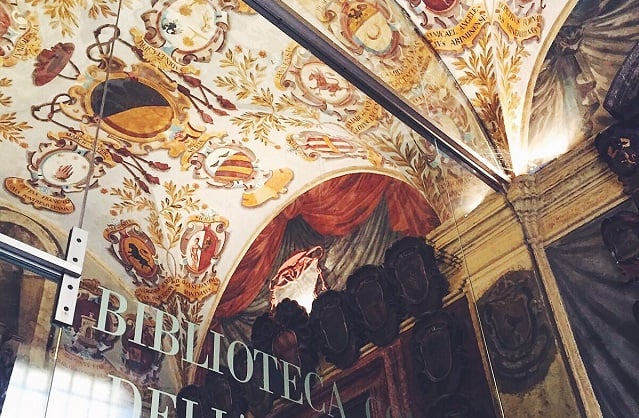
The library. Photo: Dina Caruso
The university is particularly noted for its medical school, and the anatomical theatre can still be visited today. It's located in the Archiginnasio of Bologna, which once acted as the main campus of the university and still houses one of the libraries, which is open to the public as well.
READ MORE: Why Bologna should be the next city you visit in Italy
As an Erasmus student of the university, I have been able to experience first hand the Italian university system - and the first few months came as a shock. One of the main differences, compared to the UK university system, is the absence of university-provided accommodation. In Italy, it's common for students to rent rooms privately, which eliminates some of the social element of university life but provides you with a greater sense of independence.
Another difference is that Italian students are able to select their exam dates out of a range of different ‘appelli’ (exam periods) throughout the academic year. If you are not prepared to sit that exam yet, you can chose to sit it in the following exam season. Whilst this provides Italian students with flexibility, it means that degree courses to not have a set amount of years in which they must be completed in - and can last for a very long time - because Italian students can continue sitting their exams until they are happy with their grade.
La grassa | The fat
Pizza and pasta may be considered emblematic of Italy, but actually every single region, city, small town, has its own piatti tipici; typical dishes. Bologna is often touted as the country's culinary capital, and with good reason.
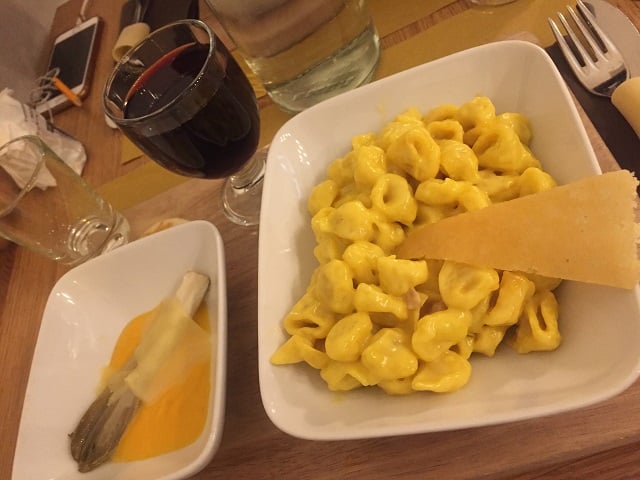
Tortellini in brodo. Photo: Dina Caruso
Some of the traditional recipes include the famous tagliatelle al ragù (the ancestor of the westernized 'spaghetti bolognese') and tortellini in brodo. Tagliatelle al ragù is made of long and flat pasta strips with the ragù sauce usually made out of minced beef, onions, celery, carrots and tomato.
Tortellini in brodo consists of small, rounded shaped pasta - with a filling usually made out of pork and Parmigiano Reggiano - in a broth.
READ MORE: Why you won't find spaghetti bolognese in Italy
Not to mention tigelle, a kind of Italian bread which is sort of similar to an English muffin and is usually eaten with a typical salumi misti board (a selection of cured meats, often including mortadella - a large pork sausage with cubes of fat, which is another typical product of the city).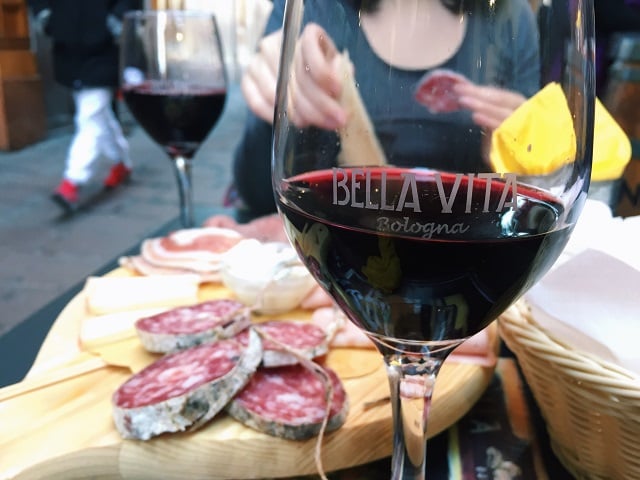
Mortadella slices - and some local wine. Photo: Dina Caruso
But something which surprised me about Bologna is the ever-growing number of organic, vegan, and vegetarian-only food outlets, which challenge the traditional cuisine. Equally, traditional ‘Italian’ cuisine is not the only kind of food that can be enjoyed in the city.
Bologna boasts a variety of different global cuisine; from Japanese, to Greek, to Mexican, I was pleasantly surprised to discover that my preconceived view of Italy offering a limited choice of global cuisine was incorrect. All in all, it's no wonder that they call it 'la grassa' - with such a wide variety of food on offer, it's hard not to put on weight while living here.
La rossa | The red
Bologna was the anti-fascist capital during the Second World War and aspects of its ‘red’ culture remain visible today, in its street art, a lively student protest culture. It's been left-leaning almost as long as it's been a city: during the Holy Roman Empire, it was a free commune. From the 12th century onwards, it began to expand and became an industrial hub, giving rise to workers' movements. During the war, it was at the heart of the Resistance movement, and was a stronghold for Italy's Communist Party for several decades after that.
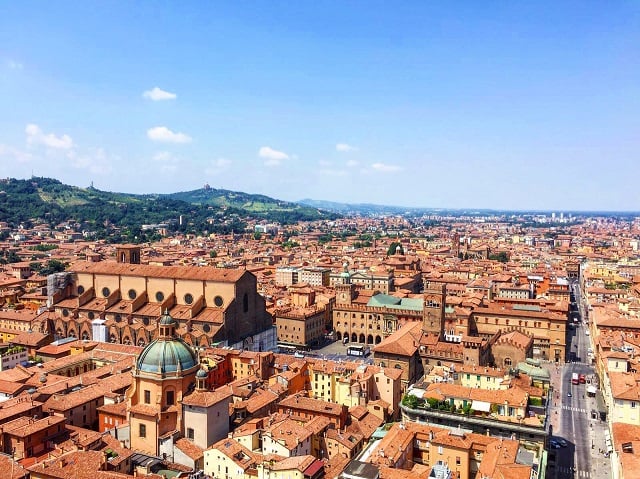
The red rooftops are the other reason for the nickname. Photo: Dina Caruso
Street art across the city pays hommage to the city’s historical connection to both anti-fascism and communism, and the 'Storia nostra, storia partigiana' artwork on the walls of Piazza Verdi, is a must see. Translating to 'Our story, the partisans' story', the piece depicts scenes with riot police, underlining the city’s past of protest and revolt.
READ ALSO: Seven faces of the Italian Resistance movement whose stories you should know
If you visit the city, wander around the student district (around Via Zamboni) - not only is this where the liveliest bars can be found, but it's where all the best street art is, as well as plenty of anti-establishment graffiti. Watch out though, because what’s there today could very well be gone tomorrow; the city’s street art is constantly changing and being painted over.
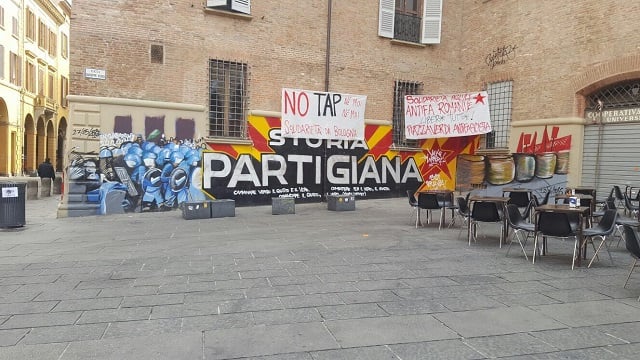
The 'Storia Partigiana' street art - as well as some more recently added protest banners. Photo: Dina Caruso
Bologna’s student protest culture also remains strong; having a lecture room change because of a protest going on outside the university is not uncommon.
One of the largest student protests I have witnessed in Bologna was the occupation of the university library. Police came inside to break up the protest, but the occupants to respond by barricading themselves inside. This encounter sparked days of protest in the university zone.
Dina Caruso is an English and Italian Literature student from the UK's University of Warwick on an Erasmus placement in Bologna, Italy. She has lived in Bologna for eight months and has fallen in love with each and every aspect of the city, while spending her spare time travelling around the rest of Italy.
Want to write a guest blog or opinion piece for The Local? Get in touch at [email protected] if you've got something to say about Italy.
Comments
See Also
Bologna, the capital city of Italy's northern Emilia Romagna, often doesn't make it onto tourist itineraries, but after a year studying here, I can't imagine living in any other city.
I didn't know much about it before moving - it was the very fact that I had no idea what it would be like that appealed to me. But one of the first things I learned was that Bologna is nicknamed by locals as 'la dotta, la grassa, la rossa' (the learned, the fat, the red), and that these names come from three characteristics which define the city: Bologna’s historical university, its mouthwatering cuisine, and the long-standing connection to Italy’s anti-fascist movement and left-wing politics.
La dotta | The learned
Bologna’s university - whose Latin name, Alma Mater Studiorum, means 'nourishing mother of studies' is the oldest continuously operating university in the western world. It boasts an illustrious list of alumni, from writers like Dante and Petrarch to four former popes, to Erasmus of Rotterdam, the namesake of the student exchange programme which today draws thousands of students to the city.
The library. Photo: Dina Caruso
The university is particularly noted for its medical school, and the anatomical theatre can still be visited today. It's located in the Archiginnasio of Bologna, which once acted as the main campus of the university and still houses one of the libraries, which is open to the public as well.
READ MORE: Why Bologna should be the next city you visit in Italy
As an Erasmus student of the university, I have been able to experience first hand the Italian university system - and the first few months came as a shock. One of the main differences, compared to the UK university system, is the absence of university-provided accommodation. In Italy, it's common for students to rent rooms privately, which eliminates some of the social element of university life but provides you with a greater sense of independence.
Another difference is that Italian students are able to select their exam dates out of a range of different ‘appelli’ (exam periods) throughout the academic year. If you are not prepared to sit that exam yet, you can chose to sit it in the following exam season. Whilst this provides Italian students with flexibility, it means that degree courses to not have a set amount of years in which they must be completed in - and can last for a very long time - because Italian students can continue sitting their exams until they are happy with their grade.
La grassa | The fat
Pizza and pasta may be considered emblematic of Italy, but actually every single region, city, small town, has its own piatti tipici; typical dishes. Bologna is often touted as the country's culinary capital, and with good reason.
Tortellini in brodo. Photo: Dina Caruso
Some of the traditional recipes include the famous tagliatelle al ragù (the ancestor of the westernized 'spaghetti bolognese') and tortellini in brodo. Tagliatelle al ragù is made of long and flat pasta strips with the ragù sauce usually made out of minced beef, onions, celery, carrots and tomato.
Tortellini in brodo consists of small, rounded shaped pasta - with a filling usually made out of pork and Parmigiano Reggiano - in a broth.
READ MORE: Why you won't find spaghetti bolognese in Italy
Not to mention tigelle, a kind of Italian bread which is sort of similar to an English muffin and is usually eaten with a typical salumi misti board (a selection of cured meats, often including mortadella - a large pork sausage with cubes of fat, which is another typical product of the city).
Mortadella slices - and some local wine. Photo: Dina Caruso
But something which surprised me about Bologna is the ever-growing number of organic, vegan, and vegetarian-only food outlets, which challenge the traditional cuisine. Equally, traditional ‘Italian’ cuisine is not the only kind of food that can be enjoyed in the city.
Bologna boasts a variety of different global cuisine; from Japanese, to Greek, to Mexican, I was pleasantly surprised to discover that my preconceived view of Italy offering a limited choice of global cuisine was incorrect. All in all, it's no wonder that they call it 'la grassa' - with such a wide variety of food on offer, it's hard not to put on weight while living here.
La rossa | The red
Bologna was the anti-fascist capital during the Second World War and aspects of its ‘red’ culture remain visible today, in its street art, a lively student protest culture. It's been left-leaning almost as long as it's been a city: during the Holy Roman Empire, it was a free commune. From the 12th century onwards, it began to expand and became an industrial hub, giving rise to workers' movements. During the war, it was at the heart of the Resistance movement, and was a stronghold for Italy's Communist Party for several decades after that.
The red rooftops are the other reason for the nickname. Photo: Dina Caruso
Street art across the city pays hommage to the city’s historical connection to both anti-fascism and communism, and the 'Storia nostra, storia partigiana' artwork on the walls of Piazza Verdi, is a must see. Translating to 'Our story, the partisans' story', the piece depicts scenes with riot police, underlining the city’s past of protest and revolt.
READ ALSO: Seven faces of the Italian Resistance movement whose stories you should know
If you visit the city, wander around the student district (around Via Zamboni) - not only is this where the liveliest bars can be found, but it's where all the best street art is, as well as plenty of anti-establishment graffiti. Watch out though, because what’s there today could very well be gone tomorrow; the city’s street art is constantly changing and being painted over.
The 'Storia Partigiana' street art - as well as some more recently added protest banners. Photo: Dina Caruso
Bologna’s student protest culture also remains strong; having a lecture room change because of a protest going on outside the university is not uncommon.
One of the largest student protests I have witnessed in Bologna was the occupation of the university library. Police came inside to break up the protest, but the occupants to respond by barricading themselves inside. This encounter sparked days of protest in the university zone.
Dina Caruso is an English and Italian Literature student from the UK's University of Warwick on an Erasmus placement in Bologna, Italy. She has lived in Bologna for eight months and has fallen in love with each and every aspect of the city, while spending her spare time travelling around the rest of Italy.
Want to write a guest blog or opinion piece for The Local? Get in touch at [email protected] if you've got something to say about Italy.
Join the conversation in our comments section below. Share your own views and experience and if you have a question or suggestion for our journalists then email us at [email protected].
Please keep comments civil, constructive and on topic – and make sure to read our terms of use before getting involved.
Please log in here to leave a comment.